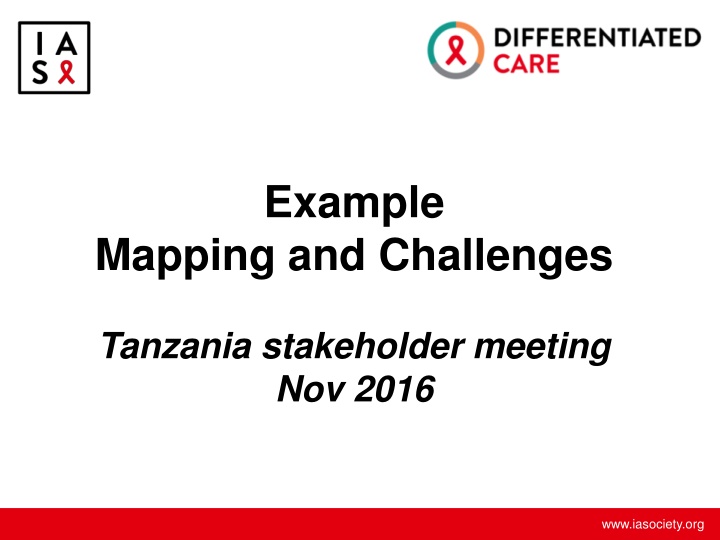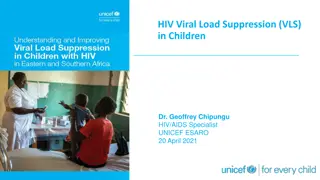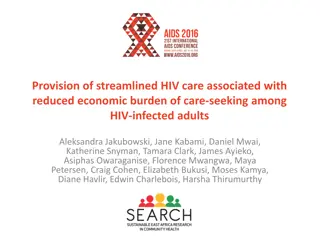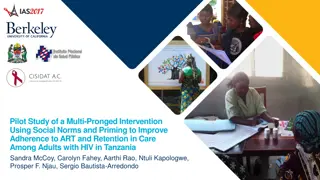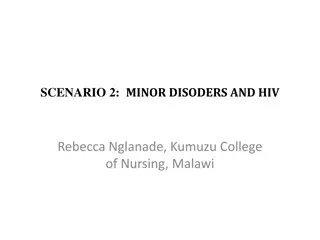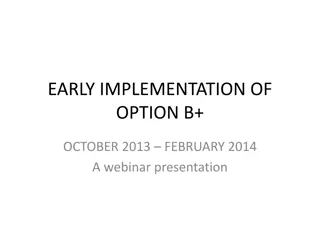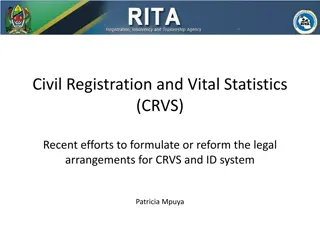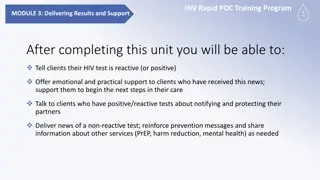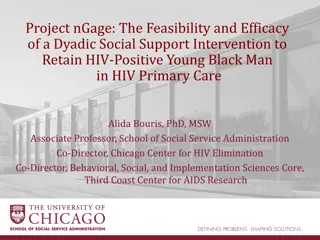Challenges and Retention in HIV Care: Insights from Tanzania Stakeholder Meeting
Explore the challenges and retention issues faced in HIV care in Tanzania, as discussed during the stakeholder meeting held in November 2016. The presentation includes data on retention rates, barriers to care, and feedback from field visits and interviews with implementing partners. Insights from East Africa highlight the reasons for patient loss to follow-up and the prevalence of psychosocial, structural, and clinic-based barriers affecting retention.
Uploaded on Oct 01, 2024 | 0 Views
Download Presentation

Please find below an Image/Link to download the presentation.
The content on the website is provided AS IS for your information and personal use only. It may not be sold, licensed, or shared on other websites without obtaining consent from the author.If you encounter any issues during the download, it is possible that the publisher has removed the file from their server.
You are allowed to download the files provided on this website for personal or commercial use, subject to the condition that they are used lawfully. All files are the property of their respective owners.
The content on the website is provided AS IS for your information and personal use only. It may not be sold, licensed, or shared on other websites without obtaining consent from the author.
E N D
Presentation Transcript
Example Mapping and Challenges Tanzania stakeholder meeting Nov 2016 www.iasociety.org
ART DELIVERY www.iasociety.org
1. Desk review www.iasociety.org
Retention on ART 2009-2014 Data from 6 regions 41 countries 304,000 patients By 6 years only 1/3 remain on treatment Retention worse for Men Children & adolescents Source: IeDEA-WHO 2015 www.iasociety.org
Retention in East Africa (1) Geng et al Clin Infect Dis. 2016 Apr Retention in Care and Patient-Reported Reasons for Undocumented Transfer or Stopping Care Among HIV-Infected Patients on Antiretroviral Therapy in Eastern Africa: Application of a Sampling-Based Approach 18 081 patients, 3150 (18%) were lost to follow-up 2 years after ART, 69% were in care at their original clinic, 14% transferred (4% official and 10% unofficial), 6% were alive but out of care, 6% died in care (<60 days after last visit), and 6% died out of care ( 60 days after last visit). www.iasociety.org
Retention in East Africa (2) Among lost patients found in care elsewhere, structural barriers (e.g., transportation) were most prevalent (65%), followed by clinic-based (e.g., waiting times) (33%) psychosocial (e.g., stigma) (27%). Among patients not in care elsewhere, psychosocial barriers were most prevalent (76%), followed by structural (51%) and clinic based (15%). www.iasociety.org
Evidence of Barriers to retention Tanzania Tomori et al AIDS Care. Barriers and facilitators of retention in HIV care and treatment services in Iringa, Tanzania: the importance of socioeconomic and sociocultural factors. lack of knowledge and misperceptions of treatment, access problems that included difficulties in reaching distant clinics pervasive poverty that left PLHIV unable to cope with out-of-pocket costs associated with their care, persistent stigmatization of PLHIV and frequent reliance on alternative healing systems instead of biomedical treatment. www.iasociety.org
2. Feedback from field visits and implementing partner interviews www.iasociety.org
PLWHIV : Waiting time and frequency of visit Q: How long, on average, do you wait for services in your health facility? 1 to 2 hours (15) 5+ hours (11) 2 to 3 hours (7) Q: How often do you receive your ART, and would you prefer a longer period? 1 time per month and prefer longer (2-3 months) (16) I receive every 2 months (5) 1 time per month and do not prefer longer (4) "I prefer to see my doctors every month because they help me" www.iasociety.org
Field Visit Data: ART Delivery Facility Level Services: WHEN 57% (12) of facilities reported offering block appointments at CTC 40% (8) facilities reported offering non-office hour ART access 48%-62% of facilities reported offering specific appointment times for children of different ages 8% (2) of facilities reported offering specific appointment times for Key Populations ( FSW MSM PWID) 14% (3) of facilities reported offering specific appointment times for Vulnerable Populations 81% (17/21) of facilities offered long ART prescription; often for mobile clients, students studying abroad and during rainy season (16 of those were for 2 month prescriptions) 8% (2/21) of facilities offered fast track refills for ART www.iasociety.org
Field Visit Data: PLWHIV Distance to clinic Q to PLWHIV (22) : How long do you travel to reach your health facility for ART and other HIV services? 30 minutes walking (9 responses) 1 hour walking (4 responses) + 2 hours walking (5 responses) 4 hours walking (4 responses) Some people traveling very long distances to get services because of stigma in their community" www.iasociety.org
PLWHIV: Where to collect ART Q to PHWHIV ( 30) : Would you prefer to get ART in your community? If yes, what place would that be? Yes, at nearby dispensary (11) Yes, at nearby duka-la-dawa/pharmacy (3) No, because of stigma in my community (9) No, I want to see my doctor at CTC (7) "It is a good idea to get ART at the community for people on ART for a long period, but it will be difficult because of stigma in the community, especially for new clients" www.iasociety.org
ART delivery Facilities: Where? 90% (19/21) of facilities offered ART refill 0% of facilities reported offering community based ART by CHWs 0% of facilities reported offering community based ART by trained expert clients 0% of facilities reported offering private outlets for ART only www.iasociety.org
Field Visit Data: Integration Facility Level Services 81% (17) of facilities reported offering integrated HIV/TB care 8% (2) of facilities reported offering integrated HIV/STI care 76% (16) of facilities reported offering integrated HIV/RCH care 86% (18) of facilities reported offering integrated HIV/PMTCT care www.iasociety.org
Challenges for retention and adherence Facility Staff Interviews CBO Staff Interviews PLHIV Interviews Refusal of clients to take ART when they feel well LTFU due to stigma in the community Frequent movement of clients to another CTC due to stigma Religious reasons against using ART, so use traditional meds Long distance to access services Drug stock outs Staff shortage resulting in long waiting times for clients Stigma towards PHLIV makes it difficult to collect drugs close to home I m afraid to disclose to my family, I cannot receive drugs at a nearby facility High travel costs to reach CTC facility Long waiting times to see clinicians Stock out of ARVs causing changes to drugs Accessing CTC during normal working hours if you re employed Lack of money to pay for transport to CTC PLHIV don t like going to government facilities because of unfriendly staff ( esp for KPs) PLHIV don t like going to government facilities because of long waiting times Stigma against PLHIV forces them to seek CTC services in distant facilities www.iasociety.org
Best Practice to support retention and adherence Facility Staff Interviews CBO Staff Interviews PLHIV Interviews Reminder calls for appointments Mobile tracking of lost to follow up Long prescription programs Decentralization of services to be closer to the community Use of block appointments Decentralize ART services to be closer to communities Increase HIV education in the community to reduce stigma Long prescription programs (especially for stable clients) Increase the number of HCWs who can provide ART Home based adherence and retention counselling PLHIV support groups Income generating activities for PLHIV www.iasociety.org
Suggested innovations to support retention and adherence Facility Staff Interviews CBO Staff Interviews PLHIV Interviews Open dispensaries closer to the community for ART It is a good idea to get ART at the community level for people on ART for a long period, but it will be difficult because of stigma in the community, especially for new clients Provide more education in the community to reduce stigma Long prescription programs (2-3 months) Increase the number of HCWs who can prescribe ART Block appointments to reduce cues Block appointments make it very fast and efficient to get services, there are no cues Long prescription programs Decentralizing services to be closer to communities Use of block appointments to reduce waiting time Train more HCWs on administering ART Outreach programs to deliver ART to rural communities Use expert clients to provide adherence counselling Integrate HIV services into other facility health services Use expert clients to track LTFU clients Use PLHIV peer experts in provision of HIV services Decentralize services so they are closer to communities Use existing support groups for ART distribution Make it mandatory for health insurance to cover HIV and AIDS costs, including transport to facilities www.iasociety.org
Interventions to support retention and Adherence from Implementing partners Multi month prescribing (outcomes LTFU and mortality lower in MMP groups) Decentralisation of refill to health centres not accredited as ART sites - bi-monthly outreach. Longitudinal study found improvement in mean weight, CD4 count, and retention (from 69% to 83%) for participating clients Follow up visit where clients choose a date for their next visit, and the clients receive a reminder phone call the day before the visit: Program has reduced percentage of patients missing appointments from 46% to 14% in 1 year www.iasociety.org
Interventions to support retention and Adherence from Implementing partners Lay Community Health Work refill ART every 3 months at community ART distribution points for stable patients on ART Outcome: 89% retention in care (of 2,162 clients taking part) after 12 months PLHIV adherence group rotates picking up ART for fellow group members (3 per group) and delivers to their homes www.iasociety.org
3. Policy assessment against WHO recommendations www.iasociety.org
Frequency of clinical and refill visits WHO Less frequent clinical consultation visits (3-6 months) (strong, moderate) Less frequent medication pick up visits (3-6 months) (strong, low) Tanzania Monthly Some exceptions for mobile clients, mobile, students studying abroad, during rainfall and people living very far from CTC (case by case) www.iasociety.org
Location of clinical review and ART refills WHO Initiation and maintenance in peripheral facilities Initiation of ART at peripheral facilities with maintenance at the community level Tanzania Decentralisation to primary care clinic Decentralise for B+ to dispensaries www.iasociety.org
Service provider Tanzania Non physician clinicians can initiate and maintain clients on ART WHO Trained and supervised non physician clinicians can initiate and maintain ART Trained and supervised CHW can dispense ART between clinical visits Trained and supervised lay providers can distribute ARV in community settings for children, adolescents and adults living with HIV www.iasociety.org
